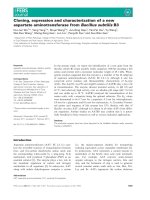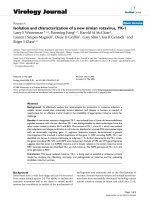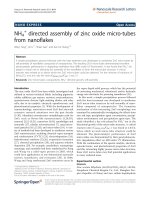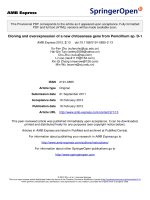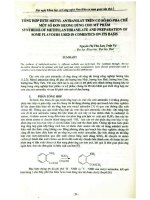1088 Preparation of some new schiff bases from 5-nitrovanillin.docx
Bạn đang xem bản rút gọn của tài liệu. Xem và tải ngay bản đầy đủ của tài liệu tại đây (562.09 KB, 11 trang )
TRƯỜNG ĐẠI HỌC SƯ PHẠM TP HỒ CHÍ MINH
TẠP CHÍ KHOA HỌC
ISSN:
1859-3100
HO CHI MINH CITY UNIVERSITY OF EDUCATION
JOURNAL OF SCIENCE
KHOA HỌC TỰ NHIÊN VÀ CÔNG NGHỆ Tập
14, Số 9 (2017): 76-84
NATURAL SCIENCES AND TECHNOLOGY
Vol. 14, No. 9 (2017): 76-84
Email: ; Website:
PREPARATION OF SOME NEW SCHIFF BASES FROM
5-NITROVANILLIN
Duong Quoc Hoan,*Nguyen Thi Hanh, Truong Minh Luong, Hoang
Thi Nhu Quynh, Nguyen Hien
Department of Chemistry - Hanoi National University of Education
Received: 03/5/2017; Revised: 02/6/2017; Accepted: 23/9/2017
ABSTRACT
A series of Schiff bases were synthesized successfully based on the condensation reaction between 5nitrovanillin and aromatic amines in moderate and high yields. The condensation underwent better in DCM
solvent, acetic acid catalyst and anhydrous MgSO4 as a drying agent and increased the yield up to 100 %.These
new Schiff bases were determined with 1H, 13C NMR spectral analysis and compound 3a was studied further
HSQC, HMBC, NOSY and MS spectra. The C=N bond exists in E conformation.
Keywords: antibacterial activity, nitrovanillin, Schiff base, vanillin.
TÓM TẮT
Tổng hợp của một số bazơ ship mới từ 5-nitrovanillin
Một dãy các bazơ Schiff mới được tổng hợp bằng phản ứng ngưng tụ giữa 5-nitrovanillin và amin thơm.
Dung mơi dichlorometan có axit axetic làm xúc tác và chất hút ẩm MgSO 4 khan. Phương pháp này làm tăng
hiệu suất của phản ứng từ 60-100%. Cấu trúc của những bazơ Schiff được nghiên cứu bằng phương pháp phổ
cộng hưởng từ hạt nhân. Riêng cấu trúc của hợp chất 3a được nghiên cứu trên cơ sở phân tích phổ cộng hưởng
từ hạt nhân hai chiều HSQC, HMBC, NOSY và phổ khối lượng MS. Liên kết C=N được chứng minh tồn tại
ở dạng cấu dạng E.
Từ khóa: bazơ Schiff, kháng khuẩn, nitrovanillin, vanillin.
1.
Introduction
Schiff bases are characterized by the -N=CH- (imine) group which imports in elucidating the
mechanism of transamination and racemization reaction in biological system [1, 2]. Schiff bases are
active against a wide range of organisms for example; Candida Albicans, Escherichia coli
Staphylococcus aureus, Bacillus polymxa, Trychophyton gypseum, Mycobacteria, Erysiphe graminis and
Plasmopora viticola. To increase the bioactive properties, Schiff bases worked as ligands in complexes
with metals showing the remarkably bioactive activities [3]. Metal-imine complexes have been
widelyinvestigated due to antitumor and herbicidal use. They can work asmodels for
*
Email:
1
Tập 14, Số 9 (2017): 7684
TẠP CHÍ KHOA HỌC - Trường ĐHSP
TPHCM
biologically important species [4]. Exploration and development of more effective
antifungal agents is necessary, and the individual Schiff bases areconsidered to be
promising antifungal medicines [5], [6].
Nitro aromatic compounds have been considered recently. For example, pyrrolnitrin
and chaloramphenicol are antibiotics; 1-nitroaknadine and aristolochic acid are natural
products that are metabolites. Nitrofen is a pesticide while the 3-nitrotyrosine works as a
signaling molecule [6].
Cl
N
O2N
OCH3
NO2
Cl
NH
H3CO
Pyrrolnitrin
O2N
HOOC
R3
R2
OCH3
OH
O
O
1-Nitroaknadinine
Aristolochic acids
(Natural products-metabolites)
(antibiotics)
NO2
NH2
Cl
2
HN
Cl
O
HO
O2N
COOH
OH OH
O
R1
O
OCH3
N
Ar
In this work
O
Cl
Cl
OH
NO2
N
Chalorampheni
col (antibiotic)
Nitrofen
(Pesticid
e)
3-Nitrotyrosine
(Signaling molecule)
Figure 1. Some examples of nitro aromatic compounds
B. R. Thorat et al.[7] reported a series of Schiff bases of 5-nitrovanillin but did not
test any their bioactivities. In Vietnam, Schiff bases of 5-nitrovanillin were investigated in
1999 [8], and showed considerable biological activities; however, some Schiff bases of 5nitrovanillin have not been test yet. In this paper, taking advantages of Schiff bases and
nitroaromatic compounds, the combination of imine group and nitroaromatic compounds is
not only hope to increase their bioactive propertiesbut also provide good sources for
synthesis of secondary amines, oxazolidine and others, Figure 1.
2.
Content
2.1. Experimental section
Solvents and other chemicals were purchased from Sigma-Aldrich, Merck were used
as received, unless indicated. The 1H NMR and 13C NMR spectra were recorded on the
Duong Quoc Hoan et
al.
Bruker Avance 500 NMR spectrometer in deuterated solvents. Chemical-shift
data for each
signal was reported in ppm units. Mass spectra were obtained from Mass Spectrometry
TẠP CHÍ KHOA HỌC - Trường ĐHSP
TPHCM
Facility of The Vietnam Academy of Science and Technology on LC-MSD-Trap-SL
spectrometer. Ethanol was redistilled after drying.
2.2. Synthetic procedure
Synthesis of 4-hydroxy-3-methoxy-5-nitrobenzaldehyde (2)[7,9]
Concentrated HNO3 (2 mL) was carefully added to a cooled (5 °C) solution of
vanillin (5 g, 33 mmol) and acetic acid (50 mL) over a period of 30 min. The gold colored
precipitate that formed was filtered, washed with water, and allowed to dry (5.21 g, 80%):
mp. 171 °C. 1H-NMR (CDCl3, 500 MHz)δ (ppm): 9.87 (s, 1H), 8.1 (d, J =2.0 Hz, 1H),
7.6
(d, J = 2.0 Hz, 1H), 3.96 (s, 3H). Rf = 0.2 (n-hexan /ethyl acetate = 2/1).
2.2.2. Synthesis of Schiff bases
General procedure:
Method 1: To a solution of 5-nitrovanillin (0.34 g, 2 mmol, 152 g/mol) and amine
(2.5 mmol) in absolute ethanol (10 mL) was added 2-3 drops of glacial acetic acid. The
mixture was refluxed for 5- 20 h. The progress of reaction was monitored with thin layer
chromatography (TLC). After reaction completion, the mixture was concentrated and then
added water (20 mL). The precipitate was filtered and washed well with water and cold
ethanol. Re-crystallization in ethanol gave pure enough product for next reaction.
Method 2: To a solution of 5-nitrovanillin (0.34 g, 2 mmol, 152 g/mol), anhydrous
magnesium sulfate (10 mmol, 1.2 g) and amine (2.5 mmol) in DCM (10 mL) was added 23 drops of glacial acetic acid. The mixture was refluxed for 2 h. Then filtration was used to
get rid of MgSO4. The mother liquid was washed with 3% HCl (5 mL x 3), dried over with
Na2SO4 and then concentrated in vacuo. The title products were purified with flash column
chromatography in eluent n-hexan and ethyl acetate (1/1).
Synthesis of 2-methoxy-4-[(E)-(naphthalen-1-ylimino)methyl]-6-nitrophenol(3a)
Following the general procedure of method 2, using 5-nitrovanillin (0.34 g, 2 mmol,
152 g/mol)and 1-naphthylamine (2.5 mmol, 0.36 g, 143 g/mol) gave 3a as a redish brown
powder (0.53 g, 82 %, 322 g/mol): m.p = 182 °C ; Rf = 0.73 (n-hexan /ethyl acetate = 2/1).
Synthesis of 2-methoxy-4-[(E)-(naphthalen-2-ylimino)methyl]-6-nitrophenol (3b)
Following the general procedure of method 2, using 5-nitrovanillin (0.34 g, 2 mmol,
152 g/mol) and 2-naphthylamine (2.5 mmol, 0.36 g, 143 g/mol) gave 3b as a reddish
brown powder ( 0.49 g, 76 %, 322 g/mol): m.p = 185 °C;1H NMR (CDCl3, 500
MHz)δ (ppm):11.07 (s, br, 1H), 8.42 (s, 1H), 8.28 (m, 1H), 8.04 (d, J = 1.5 Hz, 1H), 8.00
(d, J =
1.0 Hz, 1 H), 7.85 (m, 1 H), 7.73 (d, J = 8.5 Hz, 1H), 7.52 (t, J = 9.0 Hz, 2H), 7.45 (t, J =
8.0 Hz, 1H), 7.03 (d, J = 7.5 Hz, 1H), 4.06 (s, 3H);13C NMR (CDCl3, 125 MHz) δ
(ppm):157.3, 150.6, 149.0, 148.3, 134.0, 133.6, 128.6, 128.1, 127.7, 126.5, 126.3, 126.1,
4
125.9, 123.6, 118.6, 114.5, 112.8, 56.9. Rf = 0.75 (n-hexan/ethyl acetate = 2/1).
5
Synthesis of 2-methoxy-6-nitro-4-[(E)-(4-hydroxyphenylimino)methyl]phenol(3c)
Following the general procedureof method 2, using 5-nitrovanillin (0.34 g, 2 mmol,
152 g/mol) and 4-hydroxyanilline(2.5 mmol, 272 mg, 109 g/mol) gave 3c as a dark yellow
powder( 0.35 g, 78 %, 228 g/mol): m.p =190 °C; 1H-NMR (CDCl3, 500 MHz)δ
(ppm):
9.60 (s, 1H), 8.59 (s, 1H), 8.05 (s, 1H), 7.66 (s, 1H), 7.25 (d, J = 8.5 Hz, 2H), 6.82 (d, J =
8.5 Hz, 2H), 3.90 (s, 3H); 13C-NMR (CDCl3, 125 MHz) δ (ppm): 157.4, 150.6, 149.0,
148.2, 134.3, 133.2, 125.3, 119.8, 117.5, 116.5, 114.3, 56.8. Rf = 0.8 (n-hexan /ethyl
acetate = 2/1).
Synthesis of 4-[(E)-(2-hydroxyphenylimino)methyl]-2-methoxy-6-nitrophenol (3d)
Following the general procedure of method 2, using 5-nitrovanillin (0.34 g, 2 mmol,
152 g/mol) and 2-hydroxyaniline (2.5 mmol, 0.3 g, 123 g/mol) gave3d as adark yellow
powder (0.37 g, 62 %, 302 g/mol): m.p= 168 °C;1H-NMR (DMSO, 500 MHz)δ
(ppm): 8.62 (d, J = 1.5 Hz, 1H), 8.06 (d, J = 1.5 Hz, 1H), 7.69 (s, 1H), 7.34 (d, J = 9.0
Hz, 2H),
7.01 (d, J = 9.0 Hz, 2H), 3.92 (s, 3H), 3.78 (s, 3H).13C-NMR (CDCl3, 125 MHz) δ (ppm):
158.7, 154.9, 152.8, 150.5, 148.7, 143.8, 139.9, 133.6, 128.3, 122.2, 118.2, 116.4, 114.8,
114.5, 114.2, 56.9, 55.7, 55.5. Rf = 0.8 (n-hexan /ethyl acetate = 2/1).
Synthesis of 4-[(E)-(4-methoxyphenylimino)methyl]-2-methoxy-6-nitrophenol(3e)
Following the general procedure of method 2, using 5-nitrovanillin (0.34 g, 2 mmol,
152 g/mol) and 4-methoxyaniline (2.5 mmol, 0.27 g, 109 g/mol) gave3e as a dark yellow
powder (0.38 g, 67 %, 288 g/mol): m.p = 172 °C;1H-NMR (CDCl3, 500 MHz)δ
(ppm):
8.60 (s, 1H), 8.08 ( d, J = 2.0 Hz, 1H), 7.82 (d, J = 2.0 Hz, 1H), 7.27 (dd, J = 8.5, 1.5 Hz,
1H), 7.22 (td, J = 8.0, 1.5 Hz, 1H), 7.03 (br, 1H), 7.03 (dd, J = 8.0, 2.0 Hz, 1H), 6.92 (td, J
= 8.5, 1.0 Hz, 1H), 4.05 (s, 3H).13C-NMR (CDCl3, 125 MHz) δ (ppm): 154.4, 152.1, 150.7,
149.1, 134.9, 133.7, 129.5, 127.5, 120.3, 118.6, 116.4, 115.3, 114.2, 56.9; Rf = 0.7 (nhexan /ethyl acetate = 2/1).
3.
Results and Discussion
3.1. Synthesis
The five Schiff bases were synthesized successfully shown in the Scheme 1. These
compounds were checked on Scifinder in the Leuven University (Belgium).
Scheme 1. Synthesis of the target compounds
First of all, vanillin (1) was nitrated in cold condition and mixture reagent of HNO3
and H2SO4 giving 5-nitro vanillin in 80 %. This compound was checked with 1H NMR
spectrum. Then, 5-nitro vanillin was condensed with aromatic amine gave Schiff bases 3a,
3b, 3c, 3d and 3e in moderate and good yield. Since they have long conjugation system,
they are darkish yellow. The traditional method (method 1) gave yield lower than 50%. We
also tried condition including MgSO4 in DCM without acetic acid gave low yield too.
Method 2 using MgSO4 (5 eq.) and 1 drop of acetic acid was the best in our cases. In
aniline case, the yield was about 100%, other cases their yields were 60 ÷ 85 %. The unreacted amine was washed with 3% HCl. Therefore, after work up the crude products can
be used for next step without further purification.
3.2. Structure determination
To understand the structures of these Schiff bases, compound 3a, one of the most
complicated compounds, was chosen to study 1H NMR, 13C NMR, HMBC and MS
spectra. First of all, the negative mass spectrum showed a base pick at m/z 321 au and the
positive mass spectrum showed a peak at m/z 323 au. That indicated the molecular weight
of compound 3a must be 322 g/mol matching with the designed product, expectedly,
Figure 2.
Figure 2. Part of HMBC and MS spectra of compound 3a
Secondly, retention factor of compound 3a was much bigger than that of 5nitrovanillin (2) (see experimental section). In addition, melting points of all Schiff bases
were higher than that of 5-nitrovanillin due to molecular mass increased. Thirdly, 1H NMR
spectrum of compound 3aindicated 14 protons including a broaden proton at δ 11.08 ppm
was for H (OH), at δ 8.48 ppm for H8 and 3 protons at δ 4.09 ppm for H7. There were two
doublet of doublet peaks at δ 8.29 and 7.86 ppm for either H16 or H15. There were doublet
peaks at δ8.08 and 8.03 ppm with splitting constant about 1.0 ÷ 2.0 Hz which were for H2
or H6. Another pair of doublets was at δ 7.74 ppm and δ 7.04 ppm with splitting constant
about 8.5 Hz that must be for H10 or H12. A unique triplet at δ 7.46 ppm was H11 due to
their ortho position of both H10 and H12. Unfortunately, H14 and H17 overlapped each
other giving a multiplet although each was a doublet of doublet peak. 13C NMR spectrum
of compounds 3a indicated 18 peaks associated with 18 carbon atoms. Certainly, peak at δ
56.9 ppm was assigned for C7. Others carbons were not identified on the 13C NMR
spectrum. The HSQC cross peaks show the carbons bearing protons that combined with the
HBMC cross peaks; therefore, all carbons and protons were assigned as shown in Table 1
and Figure 2. For instance, H7 had a cross peak with C3 that had a weak cross peak with
H2 indicating the assignment of H2 from H6. Another example is that H10 and H12 were
the doublet but H10 had a cross peak with C8 that bound the proton at δ 8.45 ppm.
Table 1. NMR spectral analysis of compound 3a (ppm, Hz)
10
7
H3CO
2
1
6
HO
9
2
12
13
N
14
18
15
5
NO
1
1
17
16
3a
1
H NMR
H2
H6
13
HSQC
HMBC
8.08 (d, J = 1.5 Hz, 1H)
8.03 (d, J = 1.0 Hz, 1H)
C NMR
C1
C2
C3
C4
C5
C6
133.6
118.6
150.7
149.0
157.3
114.6
H2xC2
H6xC6
H7
4.09 (s, 3H)
C7
56.9
H7xC7
H8
8.45 (s, 1H)
C8
128.1
H8xC8
H10
7.04 (d, J = 8.5 Hz, 1H)
C9
C10
148.4
126.5
H10xC10
H11
7.46 (t, J = 8.0 Hz, 1H)
C11
127.7
H11xC11
H12
7.74 (d, J = 7.5 Hz, 1H)
C12
112.8
H12xC12
H14
7.52 (m, 1H)
C13
C14
134.0
126.3
H14xC14
H15
7.86 (dd, J = 7.0, 2.0 Hz, 1H)
C15
125.9
H15xC15
H16
8.29 (dd, J = 7.0, 2.5 Hz, 1H)
C16
123.6
H16xC16
H17
7.52 (m, 1H)
C17
126.0
H17xC17
H(O)
11.08 (br, s, 1H),
C18
-
128.6
-
-
C1xH2
H2xC6, C4, C5, C3
C3x H7
C4xH2, H6
C5xH2, H6
H6xC2, C4, C5
C6xH8, H2
H7xC3
C7x H8xC6, C2, C9,
C8xC9x H8, H11
H10xC12, C18
C10xH12
H11x C13, C9
C11xH12 xC14, C18
C12xH10
C13xH11
H14xC14xH16
H15xC17
C15xH16xC14
C16xH17xC17xH15
C18xH10, H12
-
NMR spectral analysis of other compounds3b, 3c, 3d and 3e was shown in the
experimental section. All agreed with the expected products. Interestingly, compound 3d
was observed the tautomerization around the imine bond in CDCl3; consequently, 13C
NMR spectrum was more complicated. Changing to DMSO solvent reduced that
observation as shown.
Figure 3. A part of NOSY NMR spectrum of compound 3a
In order to confirm E-conformation of the Schiff bases, NOSY spectrum of
compound 3a was studied, Figure 3 and Figure 4. It was found that the conformation of 3a
must be the E-3a. Because the cross peak a showed the H8 and H10 that were close to
each other. In addition, the cross peak b improved that distance between H8 and H2 in
space are short enough (see E-3a, in Figure 4). Interestingly, there were no data to see the
naphthyl group flipped over to have a cross peak of H17 and H8 in the case of E-3a’ in the
NOSY spectrum.
Figure 4. Some examples of E and Z conformations around C=N bond
4.
Conclusion
Five new Schiff bases were synthesized by condensation reaction between 5nitrovanillin and aromatic amines. The modification method of condensation reaction
including drying reagent anhydrous MgSO4, catalysis acetic acid in dry DCM was used to
give high yield. Structures of Schiff bases were determined with spectroscopy methods
such as NMR and MS. E conformation of C=N bond was determined with NOSY NMR
spectrum.
[1]
[2]
[3]
[4]
[5]
[6]
[7]
[8]
[9]
REFERENCES
K.Y. Lau, A. Mayr, K. K. Cheung, “Synthesis of transition metal isocyanide complexes
containing hydrogen bonding sites in peripheral locations,” Inorg. Chem. Acta., 285, 223,
1999.
A.S. Shawali, N. M. S. Harb, K.O. Badahdah, “A study of tautomerism in diazonium
coupling products of 4-hydroxycoumarin,” J. Heterocylic Chem., 22, 1397, 1985.
A. Golcu, M. Tumer, H. Demirelli, R. Wheatley, “Cd(II) and Cu(II) complexes of
polydentate Schiff base ligands: synthesis, characterization, properties and biological
activity,”Inorg. Chim. Acta, 358, pp.1785–1797.
M. Abdul-Gawad, Y. M. Issa, S. M. Abd-Alhamid, “Spectrophotometric and
Potentiometric Studies on some Salicylidene-Sulpha Derivatives,” Egypt J. Pharm. Sci., 34,
219, 1993..
W. Rehman, M. K. Baloch, B. Muhammad, A. Badshah, K. M. Khan, “Characteristic
spectral studies and in vitro antifungal activity of some Schiff bases and their organotin
(IV) complexes”, Chin. Sci. Bull., 49, pp.119–122, 2004.
Kou-San Ju and R. E. Parales, “Nitroaromatic Compounds, from Synthesis to
Biodegradation,” Microbiology And Molecular Biology Reviews, pp.250-272, 2010; K.
Brodowska and E., łodyga-Chruścińska, “Schiff bases – interesting range of applications in
various fields of science”, Chemik., 68, pp.129-134, 2014).
B. R. Thorata, M. Mandewalea, S. Shelke, P. Kamat, R. G. Atrama, M. Bhalerao, R.
Yamgara, “Synthesis of novel Schiff bases of 4-hydroxy-3-methoxy-5-nitrobenzaldehyde
and Development of HPLC Chromatographic Method for their analysis,” J. Chem. Pharm.
Re., 4(1), pp.14-17, 2012.
Giang Thi Son, Tran Manh Binh, Nguyen Kim Thu, Le Thi Phuong, “Tổng hợp và khảo sát
hoạt tính sinh học của một vài azometin chứa nhóm nitro,” Tạp chí dược, 7, tr.383-383,
1999; Pham Thi Minh Thuy, Phan Thuc Anh, Đo Van Luan, “Tổng hợp một vài dẫn xuất của
5-nitrovanillin và hoạt tính sinh học của chúng,” Tạp chí dược, 3, pp.369-370, 1999.
B. Karl and W. T. Eng, “Synthesis and evaluation of bifunctional nitrocatechol inhibitors of
pig liver catechol-O-methyltransferase,” Bioorg. Med. Chem., 13, pp.5740-5749, 2005.


